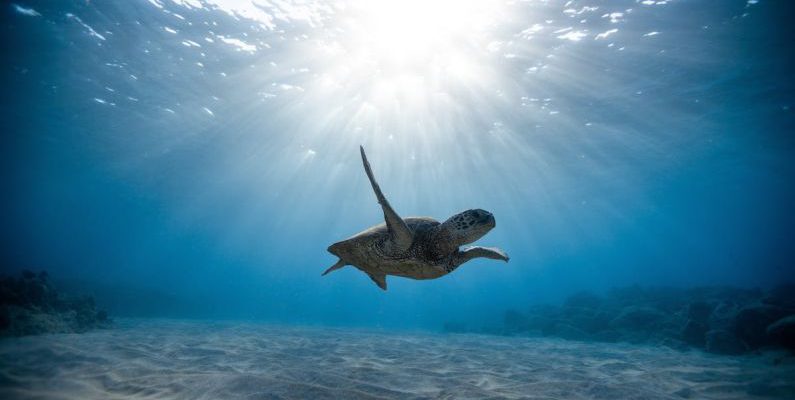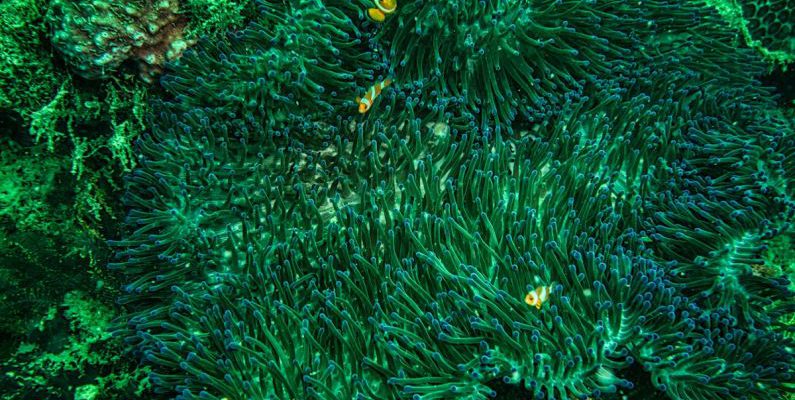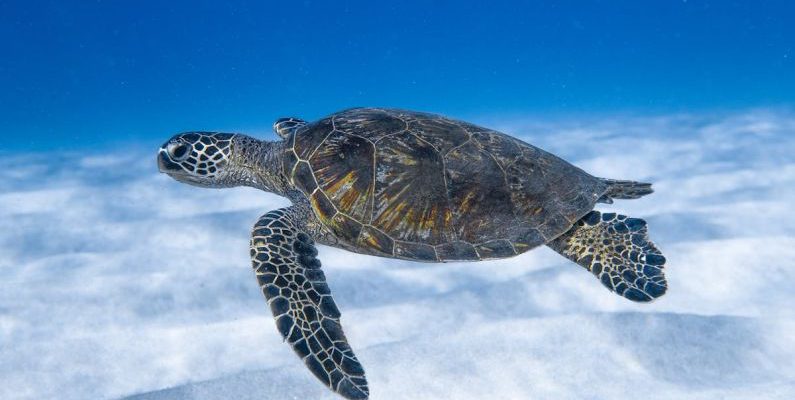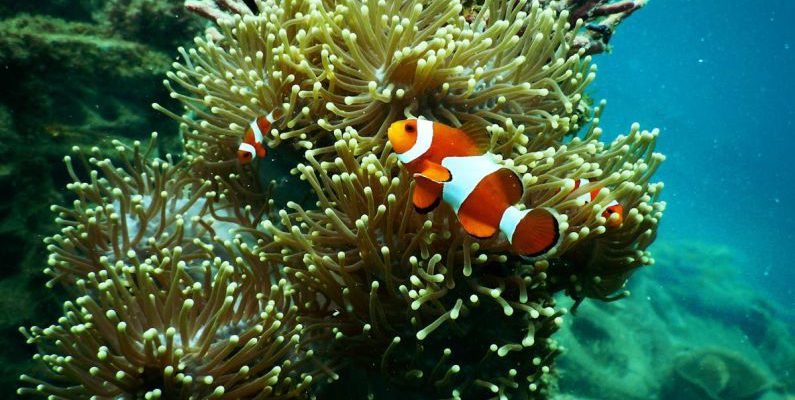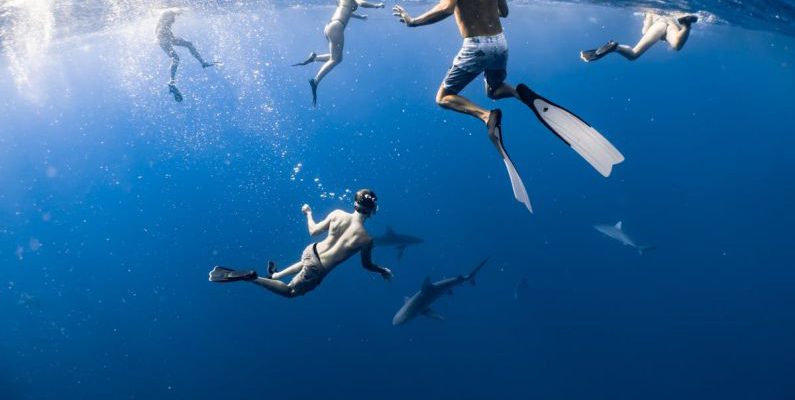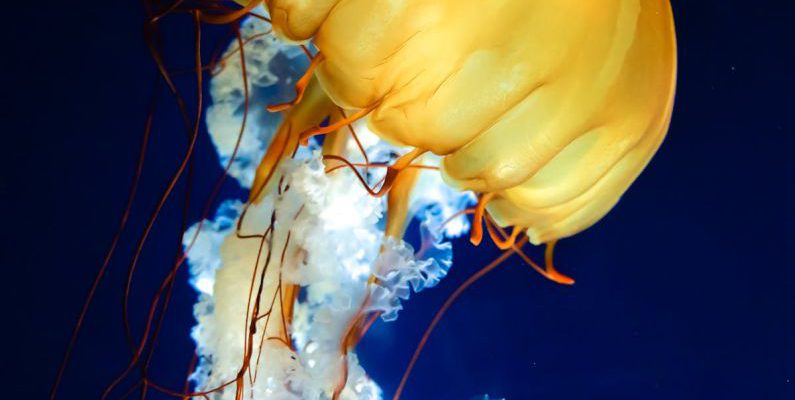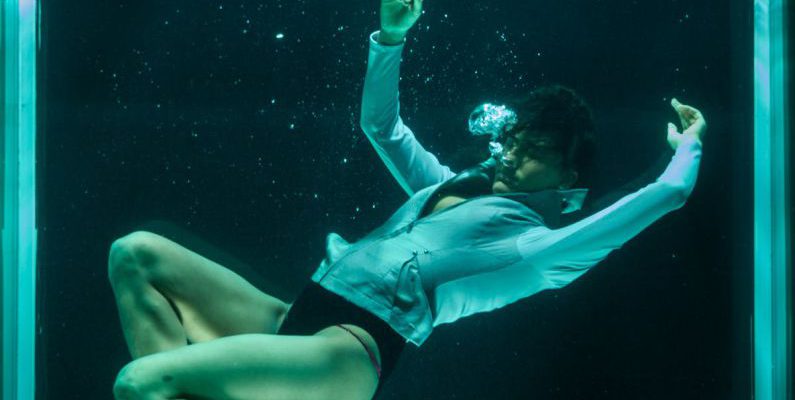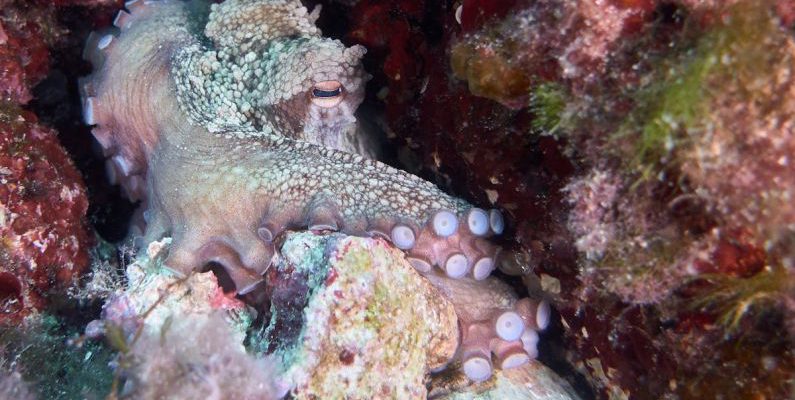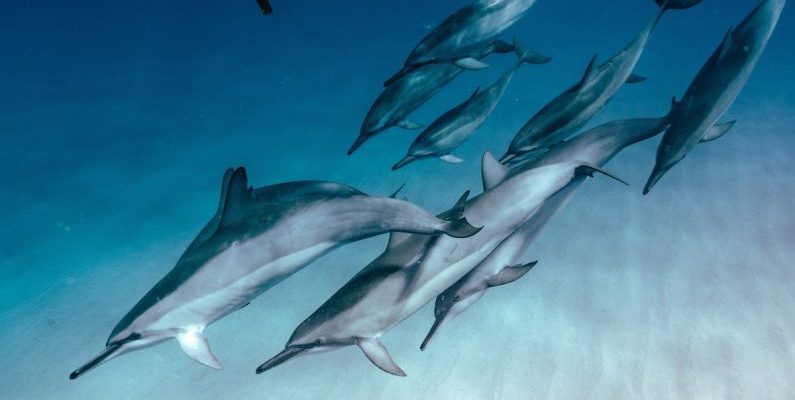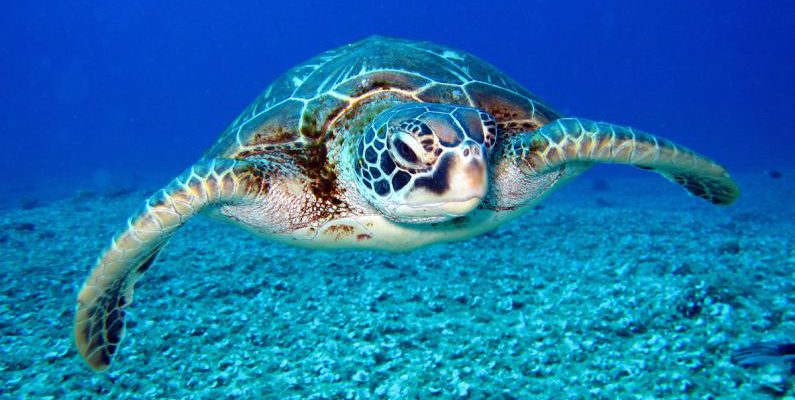When we think of marine life, majestic whales, colorful coral reefs, and playful dolphins often come to mind. However, there is a group of organisms that play a crucial role in the ocean ecosystem but often go unnoticed - plankton. These tiny organisms, consisting of phytoplankton and zooplankton, are the unsung heroes of marine life, supporting the entire ocean food web and contributing significantly to the health of our planet's oceans.
Marine Life
In Marine Life
The vast expanses of the world's oceans hold a myriad of mysteries and wonders, including the intricate ecosystems that thrive around wrecks and reefs. These artificial structures, whether intentionally created or the result of human activity, provide vital habitats for a diverse array of marine life. From colorful corals to elusive fish species, these underwater environments offer a glimpse into the remarkable adaptability of organisms in the face of changing landscapes. Let's delve into the fascinating world of wrecks and reefs and explore the crucial role they play in supporting marine biodiversity.
The Allure of Wrecks
Wrecks, whether sunken ships or submerged aircraft, hold a special fascination for divers and marine enthusiasts alike. These man-made structures serve as a poignant reminder of past events and provide a unique backdrop for marine life to flourish. Over time, wrecks become encrusted with corals, sponges, and algae, transforming them into vibrant underwater oases teeming with activity. One of the key attractions of wrecks is their ability to harbor a wide range of species that may not be commonly found in natural reef environments. The complex nooks and crannies of wrecked vessels provide shelter for various fish species, crustaceans, and invertebrates, creating a bustling microcosm beneath the waves. For some marine creatures, wrecks offer a safe haven where they can feed, breed, and seek refuge from predators.The Ghostly Beauty of Artificial Reefs
Artificial reefs, intentionally created structures designed to enhance marine habitats, are another critical component of the underwater landscape. Constructed from materials such as concrete, steel, and old tires, these artificial reefs mimic the structural complexity of natural reefs and provide a substrate for coral growth and colonization by marine organisms. One of the most striking aspects of artificial reefs is their ability to attract a diverse array of marine life, from tiny invertebrates to majestic apex predators. The gradual process of colonization and succession on artificial reefs mirrors the natural evolution of coral reef ecosystems, albeit at an accelerated pace. Over time, these once barren structures become veritable hotspots of biodiversity, supporting a complex web of interactions among different species.The Role of Artificial Habitats in Conservation
Beyond their aesthetic appeal and recreational value, wrecks and artificial reefs play a crucial role in marine conservation efforts. By providing additional habitats for marine organisms, these structures help alleviate pressure on natural reefs, which are increasingly threatened by climate change, pollution, and overfishing. Artificial habitats can serve as refuges for vulnerable species, helping to bolster their populations and enhance overall ecosystem resilience. Moreover, wrecks and artificial reefs offer valuable opportunities for scientific research and monitoring. By studying the ecological dynamics of these artificial habitats, researchers can gain insights into the processes of colonization, succession, and community development in marine environments. This knowledge is essential for informing conservation strategies and guiding the sustainable management of marine resources.Exploring the Depths: A Window into the Underwater World
For divers and underwater enthusiasts, wrecks and artificial reefs present an unparalleled opportunity to explore the hidden wonders of the ocean. The eerie beauty of a sunken ship enveloped in marine life, or the bustling activity of a vibrant artificial reef, offers a glimpse into the intricate interconnectedness of marine ecosystems. By venturing into these underwater realms, we can witness firsthand the resilience and adaptability of marine life in the face of changing environments. In conclusion, wrecks and reefs serve as poignant reminders of human impact on the marine environment and the remarkable ability of nature to reclaim and thrive in even the most unlikely of habitats. These artificial homes of marine life not only provide vital habitats for a diverse array of species but also offer valuable insights into the complex dynamics of marine ecosystems. By appreciating and protecting these underwater treasures, we can ensure the continued health and biodiversity of our oceans for generations to come.
In Marine Life
In the intricate underwater world of coral reefs, one of the most fascinating and mutually beneficial relationships exists between the clownfish and the anemone. This symbiotic partnership, often portrayed in popular culture due to its appearance in the animated film Finding Nemo, goes beyond just the visual appeal it offers. Let's delve into the captivating dynamics of this unique bond between these two marine creatures.
The Anemone's Protective Shelter
Anemones are stationary marine creatures belonging to the same family as jellyfish and corals. These colorful and often venomous creatures provide shelter and protection for clownfish. The tentacles of the anemone contain stinging cells called nematocysts, which serve as a defense mechanism against predators. While these tentacles can be harmful to other fish, clownfish have developed a special mucus layer that makes them immune to the anemone's sting. In return for the safe haven provided by the anemone, clownfish help to attract prey towards the anemone with their bright colors and movements. This mutually beneficial arrangement ensures that both species have a constant supply of food and protection in the bustling ecosystem of the coral reef.Clownfish: The Cleaners of the Anemone
One of the most crucial roles that clownfish play in their relationship with anemones is acting as cleaners. Anemones are susceptible to parasites and debris that can hinder their ability to catch food effectively. Clownfish help to keep the anemone's tentacles clean by removing parasites and algae, thus ensuring that the anemone remains healthy and can continue to provide shelter for the clownfish. The clownfish's cleaning behavior is not only beneficial for the anemone but also serves as a source of food for the clownfish. They feed on the parasites and algae they remove from the anemone, creating a self-sustaining cycle within their shared habitat.Communication and Recognition
Clownfish and anemones have evolved a unique system of communication and recognition that allows them to coexist harmoniously. Each species recognizes the other through chemical cues, with clownfish being able to detect and differentiate between various species of anemones based on these cues. Additionally, clownfish exhibit specific behaviors that signal their intentions to the anemone. For example, when a clownfish wants to establish a bond with an anemone, it will gently touch its tentacles with different parts of its body to acclimate the anemone to its presence. This communication helps to prevent the anemone from perceiving the clownfish as a threat, ultimately leading to the formation of a successful partnership.The Impact of Climate Change
While the symbiotic relationship between clownfish and anemones has evolved over millions of years, it is not immune to the threats posed by human activities such as climate change. Rising sea temperatures, ocean acidification, and pollution are all factors that can negatively impact coral reefs and the organisms that depend on them for survival. As coral reefs face increasing stress, the delicate balance of the clownfish-anemone relationship is at risk. Bleaching events, where corals expel the algae living in their tissues, can lead to the decline of anemone populations, consequently affecting the availability of suitable habitats for clownfish. Protecting this symbiotic relationship requires concerted efforts to conserve coral reefs and mitigate the impacts of climate change. By safeguarding the health of coral ecosystems, we can ensure the continuation of the unique bond between clownfish and anemones for future generations to marvel at.Preserving a Precious Partnership
The symbiotic relationship between clownfish and anemones serves as a testament to the interconnectedness of life in the ocean. Through their mutually beneficial interactions, these two species have forged a bond that highlights the beauty and complexity of nature's intricate web. As we strive to protect our oceans and the diverse marine life they support, let us not forget the significance of preserving partnerships like that of the clownfish and the anemone. By understanding and valuing these symbiotic relationships, we can work towards a more sustainable future where marine ecosystems thrive and flourish in all their wondrous diversity.
In Marine Life
The ocean covers more than 70% of the Earth's surface, and within its depths lies a world that is still largely unexplored. The deep sea, with its mysterious and extreme conditions, is home to some of the most bizarre and fascinating creatures on the planet. From bioluminescent jellyfish to giant squid, the deep sea is filled with creatures that challenge our understanding of life on Earth.
The Abyssal Zone: A World of Darkness and Pressure
One of the most inhospitable regions of the ocean is the abyssal zone, where sunlight cannot penetrate and pressure reaches crushing levels. Despite these extreme conditions, life thrives in this dark and cold environment. Deep-sea creatures in the abyssal zone have evolved unique adaptations to survive in such harsh conditions. One of the most bizarre deep-sea creatures found in the abyssal zone is the anglerfish. Known for its bioluminescent lure that hangs in front of its mouth, the anglerfish uses this light to attract prey in the darkness. The male anglerfish is significantly smaller than the female and attaches itself to her body, essentially becoming a parasite. This unique reproductive strategy is just one example of the strange and fascinating adaptations that deep-sea creatures have developed to survive in their extreme environment.Creatures of the Midnight Zone: Bioluminescence and Adaptations
Descending even deeper into the ocean, we enter the midnight zone, where sunlight cannot reach and temperatures drop to near freezing. Despite the darkness, the midnight zone is a place of vibrant bioluminescence, with many deep-sea creatures producing their own light to communicate, attract prey, or deter predators. One of the most mesmerizing deep-sea creatures found in the midnight zone is the vampire squid. Despite its ominous name, the vampire squid is a small, harmless creature that uses bioluminescent light to confuse its predators. With its webbed arms and red eyes, the vampire squid is a testament to the incredible diversity of life in the deep sea.The Hadal Zone: Extreme Depths and Unseen Creatures
The hadal zone, which includes the deepest parts of the ocean such as the Mariana Trench, is the least explored and most extreme environment on Earth. At depths exceeding 6,000 meters, the creatures that inhabit the hadal zone have evolved to withstand immense pressure and complete darkness. One of the most enigmatic deep-sea creatures found in the hadal zone is the giant isopod. Resembling a prehistoric creature, the giant isopod is a scavenger that feeds on the carcasses of dead animals that sink to the ocean floor. With its armored exoskeleton and powerful jaws, the giant isopod is a formidable predator in the deep sea.Unveiling the Mysteries of the Deep
The deep sea is a realm of endless mystery and discovery, with new species being found on a regular basis. From the bizarre adaptations of anglerfish to the otherworldly beauty of bioluminescent jellyfish, the deep sea is a treasure trove of strange and wonderful creatures that continue to captivate scientists and explorers alike. As we continue to explore the depths of the ocean, who knows what otherworldly creatures we may encounter and what secrets of the deep sea we may uncover.
In Marine Life
Coral reefs are among the most vibrant and diverse ecosystems on our planet, teeming with life and color beneath the crystal-clear waters. These underwater structures, formed by colonies of tiny organisms called coral polyps, play a crucial role in marine biodiversity and the health of our oceans. In this article, we will delve into the different types of coral reefs, the threats they face, and the conservation efforts aimed at preserving these invaluable natural wonders.
### Types of Coral Reefs
#### Fringing Reefs
Fringing reefs are the most common type of coral reef and are found close to the shorelines of continents and islands. These reefs grow directly from the shorelines and form a border along the coast, providing essential habitat for a wide variety of marine species. Fringing reefs often have a shallow lagoon between the reef and the shore, creating a unique ecosystem rich in biodiversity.#### Barrier Reefs
Barrier reefs, as the name suggests, are separated from the mainland or island by a lagoon. These reefs are typically larger and more developed than fringing reefs, with deeper lagoons between the reef and the shore. The Great Barrier Reef in Australia is the largest barrier reef in the world and is renowned for its stunning marine life and intricate coral formations.#### Atolls
Atolls are circular or horseshoe-shaped reefs that form around submerged volcanic islands or seamounts. Over time, as the volcanic island erodes and sinks, the coral reef continues to grow upward, creating a ring-shaped structure with a central lagoon. Atolls are often found in remote areas of the ocean and are home to a diverse array of marine species adapted to the unique conditions of these isolated ecosystems.### Threats to Coral Reefs
#### Climate Change
One of the most significant threats facing coral reefs today is climate change. Rising sea temperatures due to global warming can cause coral bleaching, a phenomenon in which corals expel the algae living in their tissues, leading to the loss of color and vital nutrients. Without these algae, corals become stressed and are more susceptible to disease and death, resulting in widespread coral bleaching events around the world.#### Ocean Acidification
Another consequence of climate change is ocean acidification, which occurs when the oceans absorb excess carbon dioxide from the atmosphere. This process lowers the pH of the water, making it more difficult for corals to build their calcium carbonate skeletons. Ocean acidification can weaken coral structures and hinder their growth and reproduction, ultimately threatening the long-term survival of coral reefs.#### Overfishing and Destructive Practices
Overfishing and destructive fishing practices, such as blast fishing and cyanide fishing, can devastate coral reef ecosystems by depleting fish populations and damaging coral structures. When key fish species are removed from the ecosystem, the delicate balance of the reef is disrupted, leading to cascading effects on other marine organisms and the overall health of the reef.### Conservation of Coral Reefs
#### Marine Protected Areas
Marine protected areas (MPAs) play a crucial role in conserving coral reefs by establishing designated zones where fishing and other activities are restricted or prohibited. These protected areas help to safeguard critical habitats, restore fish populations, and promote the recovery of damaged reefs. By creating a network of MPAs around the world, we can ensure the long-term health and resilience of coral reef ecosystems.#### Sustainable Tourism
Sustainable tourism practices, such as responsible diving and snorkeling, can help minimize the impact of human activities on coral reefs. By promoting eco-friendly tourism initiatives and supporting local communities that depend on reef ecosystems for their livelihoods, we can ensure that coral reefs are protected for future generations to enjoy.#### Coral Reef Restoration
Coral reef restoration projects aim to rebuild damaged or degraded reefs through techniques such as coral transplantation, artificial reef structures, and habitat restoration. By actively restoring coral reefs and enhancing their resilience to environmental stressors, we can help these vital ecosystems recover and thrive in the face of ongoing threats.### Preserving Our Underwater Treasures
Coral reefs are not only breathtakingly beautiful but also essential to the health of our oceans and the global biodiversity they support. By understanding the different types of coral reefs, recognizing the threats they face, and actively participating in conservation efforts, we can work together to protect these invaluable underwater treasures for future generations to marvel at and cherish. Let us all do our part to preserve and safeguard the fragile beauty of coral reefs for the benefit of all life on Earth.
In Marine Life
When it comes to the ocean's most notorious predators, sharks often take the spotlight. These majestic creatures have long been the subject of fascination and fear, with many myths and misconceptions surrounding them. For those who dare to venture beneath the waves and encounter these creatures up close, separating fact from fiction is crucial. Let's delve into the world of diving with sharks to uncover the truths that lie beneath the surface.
The Reality of Shark Behavior
One of the most pervasive myths about sharks is that they are mindless killing machines constantly on the hunt for human prey. In reality, sharks are intelligent and curious animals with a complex range of behaviors. While it's true that some species of sharks can be dangerous to humans, the vast majority of shark encounters are non-threatening. Sharks are apex predators that play a crucial role in maintaining the health of ocean ecosystems, and most attacks on humans are cases of mistaken identity.Understanding Shark Attacks
Shark attacks, while rare, do happen. It's important to note that sharks don't view humans as their natural prey. In most cases, attacks occur when a shark mistakes a human for its usual prey, such as seals or sea lions. This is known as a "hit and run" attack, where the shark quickly realizes its mistake and moves on. The likelihood of a shark attacking a human is extremely low, and the vast majority of shark species pose no threat to swimmers or divers.Diving Safely with Sharks
For those interested in diving with sharks, safety should always be a top priority. While sharks are not the mindless killers they are often portrayed to be, it's essential to respect these animals and follow proper diving protocols. Dive operators who specialize in shark encounters are well-trained in shark behavior and know how to minimize risks during dives. By following their guidance and remaining calm and respectful in the water, divers can have unforgettable and safe encounters with these magnificent creatures.The Importance of Conservation
As apex predators, sharks play a vital role in maintaining the balance of ocean ecosystems. However, shark populations worldwide are facing significant threats from overfishing, habitat destruction, and bycatch. Conservation efforts are crucial to protect these animals and ensure their survival for future generations. By supporting shark conservation initiatives and advocating for sustainable fishing practices, divers can help protect these incredible creatures and the oceans they call home.Dispelling Myths and Fostering Understanding
Despite their fearsome reputation, sharks are not the bloodthirsty monsters they are often portrayed to be. By dispelling myths and fostering a deeper understanding of these animals, we can appreciate the beauty and importance of sharks in the marine environment. Diving with sharks offers a unique opportunity to witness these creatures in their natural habitat and gain a newfound respect for their role in the ocean ecosystem. Through education and responsible diving practices, we can ensure that sharks continue to thrive in the world's oceans.
In Marine Life
In the depths of the ocean, a mesmerizing phenomenon occurs every night - bioluminescence. This natural light show, produced by various marine organisms, illuminates the dark waters with a magical glow. From tiny plankton to larger fish and even some sharks, bioluminescence is a common trait found in many creatures of the deep sea. Let's delve into the captivating world of bioluminescence and explore the science behind this enchanting display.
The Science of Bioluminescence
Bioluminescence is the production and emission of light by living organisms. This light is created through a chemical reaction that involves luciferin, a light-emitting pigment, and an enzyme called luciferase. When luciferin reacts with oxygen in the presence of luciferase, it produces light. This process is highly efficient, with almost 100% of the energy generated as light, making bioluminescence one of the most energy-efficient light sources in nature. The purpose of bioluminescence varies among species. Some organisms use it as a defense mechanism to startle predators or attract larger predators to prey on their attackers. Others use it for communication, mating, or even to lure prey. The diversity of functions that bioluminescence serves in marine life is truly remarkable.The Enchanting Glow of Bioluminescent Plankton
One of the most iconic displays of bioluminescence in the ocean is the shimmering glow of bioluminescent plankton. These microscopic organisms, known as dinoflagellates, emit a soft blue light when disturbed. When waves crash on the shore or a boat disturbs the water, the ocean comes alive with a brilliant display of bioluminescence. The sight of thousands of tiny lights twinkling in the dark water is truly magical and has captivated sailors and onlookers for centuries. Bioluminescent plankton are found in oceans around the world, from the Caribbean to the Maldives. Their ethereal glow serves as a natural light show, illuminating the night and enchanting all who witness it. This phenomenon is a reminder of the beauty and wonder of the natural world, hidden beneath the surface of the sea.The Dazzling Display of Bioluminescent Fish
While bioluminescent plankton steal the show with their shimmering glow, they are not the only creatures in the ocean that light up the night. Many species of fish also possess bioluminescent abilities, using light to camouflage themselves, communicate with others, or attract prey. One notable example is the anglerfish, a deep-sea creature with a bioluminescent lure that hangs in front of its mouth to attract prey. The anglerfish's glowing appendage is a deadly trap for unsuspecting fish that are drawn to the light in the darkness of the deep sea. Another fascinating example is the flashlight fish, which has bioluminescent organs located under its eyes. These organs emit light, allowing the fish to communicate with others in their school and navigate the dark waters of the ocean. The synchronized flashing of flashlight fish is a mesmerizing sight to behold, reminiscent of a silent underwater dance.The Mystique of Bioluminescent Sharks
Sharks are often portrayed as fearsome predators of the deep, but some species of sharks also exhibit bioluminescent features. The velvet belly lanternshark, for example, has light-emitting organs called photophores on its belly, which emit a soft blue-green glow. This bioluminescence helps the shark camouflage itself from predators below by blending in with the sunlight filtering down from the surface. The glowing lanternshark serves as a reminder of the hidden wonders that exist in the ocean depths. Its bioluminescent display adds to the mystique and allure of these enigmatic creatures, showcasing the beauty and complexity of marine life.Appreciating the Splendor of Bioluminescence
As we explore the fascinating world of bioluminescence in marine life, we are reminded of the incredible diversity and ingenuity of nature. From the shimmering glow of bioluminescent plankton to the dazzling displays of bioluminescent fish and sharks, the ocean is teeming with hidden treasures waiting to be discovered. Next time you find yourself by the water's edge at night, take a moment to look out into the dark expanse of the ocean. You may just catch a glimpse of the enchanting bioluminescent display that lights up the sea and ignites a sense of wonder and appreciation for the magical world beneath the waves.
In Marine Life
Diving into the vast expanse of the ocean is an experience like no other. The sense of weightlessness, the mesmerizing marine life, and the thrill of discovering hidden treasures beneath the waves make it a truly unforgettable adventure. For many divers, one of the most sought-after creatures to encounter is the elusive seahorse. With their unique appearance and elusive nature, spotting a seahorse while diving can be a rare and magical experience.
Exploring Seahorse Habitats
Seahorses are fascinating creatures that belong to the genus Hippocampus and can be found in shallow waters around the world. To increase your chances of spotting a seahorse while diving, it is essential to know where to look. Seahorses are often found in seagrass beds, coral reefs, and mangrove forests, where they can blend in seamlessly with their surroundings. These habitats provide seahorses with the perfect environment to camouflage themselves and wait for unsuspecting prey to come near.Patience is Key
Spotting a seahorse while diving requires patience and a keen eye. These small creatures are masters of disguise, often blending in with their surroundings to avoid predators. Their ability to change color and grow skin filaments further adds to their elusive nature. When searching for seahorses underwater, it is essential to move slowly and observe your surroundings carefully. Look for any unusual shapes or movements that could indicate the presence of a seahorse nearby.Seahorse Species Diversity
There are over 50 known species of seahorses, each with its unique characteristics and habitats. While some species prefer shallow waters close to shore, others can be found in deeper waters or even in estuaries. Knowing the specific species that inhabit the area where you are diving can help narrow down your search for these elusive creatures. Seahorse species vary in size, color, and behavior, making each encounter a truly special and memorable experience.Responsible Diving Practices
When diving in seahorse habitats, it is crucial to practice responsible diving to protect these delicate creatures and their environment. Avoid touching or disturbing seahorses, as this can cause unnecessary stress and harm. Maintain a safe distance and observe these fascinating creatures from a respectful distance. By following responsible diving practices, you can help ensure that seahorses continue to thrive in their natural habitats for generations to come.Capturing the Moment
Spotting a seahorse while diving is a moment to be cherished and remembered. If you are lucky enough to encounter one of these elusive creatures during your dive, take the time to observe and appreciate its beauty. Seahorses are known for their graceful movements and unique appearance, making them a favorite subject for underwater photographers. Capture the moment with your camera, but remember to do so without causing any harm or disturbance to the seahorse or its habitat.Embracing the Magic of the Ocean
Diving into the underwater world opens up a realm of endless possibilities and discoveries. Spotting a seahorse while diving is a reminder of the magic and beauty that exists beneath the waves. These enchanting creatures serve as a symbol of grace, resilience, and adaptability in the face of ever-changing ocean environments. By embracing the wonder of the ocean and respecting its inhabitants, we can continue to explore and appreciate the mysteries that lie beneath the surface.In Conclusion
Spotting the elusive seahorse while diving is a thrilling and rewarding experience for any underwater enthusiast. By exploring seahorse habitats, practicing patience, and following responsible diving practices, you can increase your chances of encountering these captivating creatures in their natural environment. Embrace the magic of the ocean, capture the moment with respect, and continue to marvel at the wonders that await beneath the waves. Dive in, explore, and let the enchanting world of seahorses inspire you on your underwater adventures.
In Marine Life
The Camouflage Mastery of Octopuses
Octopuses are truly fascinating creatures that have captured the curiosity of scientists and nature enthusiasts alike. One of the most remarkable abilities of octopuses is their incredible talent for camouflage. These elusive creatures have evolved sophisticated techniques to blend seamlessly into their surroundings, allowing them to evade predators and ambush prey effectively. Let's delve into the world of octopus camouflage and explore the incredible strategies these creatures employ to disappear into their environment.Morphing Skin: A Master of Disguise
One of the most impressive aspects of octopus camouflage is their ability to change the color and texture of their skin in a matter of seconds. Through a complex network of specialized cells called chromatophores, iridophores, and leucophores, octopuses can alter their appearance to match the colors and patterns of their surroundings with astonishing accuracy. By expanding or contracting these pigment-filled cells, octopuses can mimic the intricate patterns of coral reefs, sandy ocean floors, or even rocky surfaces, effectively becoming invisible to predators and prey alike.Texture Mimicry: Blending In Perfectly
In addition to changing their color, octopuses can also manipulate the texture of their skin to further enhance their camouflage abilities. By using specialized muscles called papillae, octopuses can create bumps, ridges, and spikes on their skin to mimic the texture of their environment. This texture mimicry allows octopuses to seamlessly blend in with various surfaces, making it nearly impossible for predators or prey to detect them. Whether hiding among rocky crevices or blending into a bed of seaweed, octopuses can adapt their skin texture to match their surroundings with incredible precision.Dynamic Camouflage: Adapting to Changing Environments
One of the most impressive aspects of octopus camouflage is its dynamic nature. Unlike other animals that rely on fixed patterns or colors for camouflage, octopuses can rapidly adjust their appearance to match changing environmental conditions. Whether moving across different types of terrain or encountering new predators, octopuses can quickly adapt their camouflage strategies to remain undetected. This ability to dynamically change their appearance in real-time sets octopuses apart as true masters of disguise in the animal kingdom.Behavioral Camouflage: The Art of Deception
In addition to their physical camouflage abilities, octopuses also exhibit remarkable behavioral strategies to enhance their disguise. One common tactic is using mimicry to imitate other animals or objects in their environment. By altering their body shape, movement patterns, or behavior, octopuses can mimic toxic animals, such as lionfish or sea snakes, to deter predators from attacking them. This clever form of behavioral camouflage not only helps octopuses avoid danger but also allows them to surprise unsuspecting prey by luring them in with deceptive tactics.Environmental Awareness: Reading the Signs
Another key aspect of octopus camouflage is their keen environmental awareness. Octopuses have a remarkable ability to assess their surroundings and quickly adapt their camouflage strategies based on visual cues and sensory information. By closely observing their environment and responding to changes in light, color, and texture, octopuses can fine-tune their camouflage to remain hidden and safe. This heightened awareness of their surroundings allows octopuses to stay one step ahead of predators and effectively blend into their habitat.The Evolution of Camouflage: A Natural Advantage
The remarkable camouflage abilities of octopuses have evolved over millions of years, providing these creatures with a significant advantage in the marine environment. By mastering the art of disguise through a combination of color, texture, behavior, and environmental awareness, octopuses have become expert hunters and elusive prey in the ocean's vast ecosystem. The evolution of these sophisticated camouflage techniques highlights the incredible adaptability and intelligence of these enigmatic creatures. In conclusion, octopuses are truly masters of camouflage, employing a diverse range of strategies to blend seamlessly into their surroundings and avoid detection. From morphing their skin color and texture to utilizing behavioral mimicry and environmental awareness, octopuses have honed their camouflage skills to perfection through millions of years of evolution. By unraveling the secrets of octopus camouflage, we gain a deeper appreciation for the complexity and beauty of nature's most elusive creatures.
In Marine Life
The ocean has always been a place of wonder and mystery, holding secrets that continue to captivate divers from around the world. Among the many awe-inspiring creatures that inhabit the depths of the sea, dolphins stand out as one of the most intelligent and playful marine animals. Encountering these majestic creatures while diving is an experience that leaves a lasting impression on anyone fortunate enough to witness it. Here, we delve into the unforgettable encounters with dolphins while diving, exploring the magic and thrill that comes with interacting with these incredible beings.
**Diving into a World of Wonder**
As you descend into the crystal-clear waters, the anticipation of what lies beneath grows with each passing moment. The rhythmic sound of your breathing mixes with the gentle currents, creating a serene atmosphere that envelops you as you explore the underwater world. Suddenly, a pod of dolphins appears in the distance, their sleek bodies gliding effortlessly through the water. You feel a surge of excitement as they draw closer, their curiosity piqued by your presence.
**A Dance of Grace and Beauty**
The dolphins move with a grace and elegance that is mesmerizing to behold. Their fluid movements and playful antics showcase their agility and intelligence, leaving you in awe of their natural beauty. As they swim circles around you, their eyes seem to sparkle with mischief, inviting you to join in their underwater dance. You can't help but be drawn into their world, feeling a sense of connection that transcends language and species.
**An Unforgettable Bond**
In the presence of dolphins, time seems to stand still as you share moments of pure joy and wonder. Their curiosity leads them to approach you, their gentle eyes meeting yours in a silent exchange of understanding. You feel a sense of peace and harmony wash over you, a deep connection forming between human and animal in the vast expanse of the ocean. The dolphins' playful nature is infectious, and soon you find yourself laughing and spinning in the water alongside them, caught up in the magic of the moment.
**A Symphony of Sounds**
As you dive deeper into the underwater world, you are enveloped by a symphony of sounds unlike anything you've ever experienced. The clicks and whistles of the dolphins echo through the water, creating a melodic backdrop to your encounter. Their vocalizations convey a sense of communication and camaraderie, drawing you further into their world of mystery and wonder. You listen intently, trying to decipher the messages hidden within their songs, feeling a sense of connection that transcends words.
**A Moment Frozen in Time**
As you reluctantly begin your ascent back to the surface, the dolphins swim alongside you, their presence a reminder of the beauty and magic that exists beneath the waves. You know that this encounter will stay with you forever, a cherished memory that brings a smile to your face whenever you recall it. The feeling of freedom and joy that engulfed you in the company of these incredible creatures is something that cannot be replicated, a moment frozen in time that will always hold a special place in your heart.
**Embracing the Magic of the Ocean**
Encounters with dolphins while diving are more than just fleeting moments of excitement – they are transformative experiences that leave a lasting impact on those lucky enough to partake in them. The sense of wonder and connection that emerges from these encounters transcends the boundaries of human understanding, reminding us of the beauty and magic that exist in the natural world. So, the next time you find yourself beneath the waves, keep your eyes and heart open to the possibility of encountering these magnificent creatures – for in their presence, you may just find a piece of yourself that you never knew was missing.
In Marine Life
Gliding effortlessly through the crystal-clear waters of the ocean, stingrays are a sight to behold. These graceful creatures, with their sleek bodies and gentle movements, captivate all who have the privilege of witnessing their underwater dance. For those who dare to venture beneath the surface and dive into the depths of the sea, encountering stingrays in their natural habitat is an experience like no other. From the moment you spot these majestic creatures to the exhilarating moments spent swimming alongside them, diving with stingrays is an unforgettable adventure that will leave you in awe of the wonders of the ocean.
Encountering the Elegance of Stingrays
As you descend into the depths of the ocean, the sunlight filters through the water, casting a mesmerizing glow on the sandy seabed below. The anticipation builds as you scan the surroundings, your eyes eagerly searching for signs of marine life. And then, suddenly, you spot them – a group of stingrays gracefully gliding through the water, their wings undulating like silk ribbons in the gentle current. Approaching these magnificent creatures with caution and respect, you feel a sense of wonder and awe at their sheer beauty. With their sleek bodies and distinctive diamond-shaped wings, stingrays move with a fluidity and grace that is truly mesmerizing. As you watch them effortlessly navigate their underwater world, you can't help but be swept away by the elegance of their movements.Swimming Alongside Stingrays
As you continue your dive, the stingrays show a curious interest in your presence, circling around you with a sense of curiosity and grace. With each gentle flap of their wings, they propel themselves effortlessly through the water, creating a mesmerizing display of fluid motion. Drawing closer to these captivating creatures, you feel a sense of connection with the underwater world unlike anything you've experienced before. The stingrays seem to move in harmony with the rhythm of the ocean, their movements synchronized and graceful. Swimming alongside them, you become part of their elegant dance, feeling the sheer joy of being immersed in the beauty of nature.The Encounter of a Lifetime
As you spend more time diving with the stingrays, you begin to appreciate the sheer magnificence of these creatures and the importance of preserving their natural habitat. Witnessing them in their element, you gain a newfound respect for the delicate balance of marine ecosystems and the need to protect and conserve the ocean's biodiversity. The encounter with stingrays leaves a lasting impression on you, a reminder of the wonders that lie beneath the surface of the ocean and the importance of preserving them for future generations to enjoy. As you resurface and take a deep breath of the salty sea air, you carry with you the memories of the graceful dance of stingrays, a moment in time that will stay with you forever.In the Realm of the Stingrays
In the realm of the stingrays, time seems to stand still as you are enveloped in the beauty and tranquility of the underwater world. The gentle movements of these majestic creatures, the play of light and shadow on the ocean floor, and the sense of wonder and awe that fills your heart – diving with stingrays is a truly magical experience that will stay with you long after you've returned to the surface. As you reflect on your encounter with these graceful creatures, you are reminded of the fragility and beauty of the natural world and the need to cherish and protect it for generations to come. The dance of the stingrays is a reminder of the interconnectedness of all life on Earth and the importance of preserving the wonders of the ocean for future generations to explore and enjoy. In the presence of the stingrays, you are humbled by the sheer majesty of the underwater world and the incredible diversity of life that inhabits it. As you bid farewell to these magnificent creatures and make your way back to the surface, you carry with you a newfound appreciation for the beauty and grace of the ocean and a deep sense of gratitude for the opportunity to witness its wonders up close. Diving with stingrays is not just an adventure – it is a transformative experience that will leave you forever changed, with a heart full of awe and a soul touched by the magic of the sea.
In Marine Life
Sea turtles are captivating creatures that have roamed the world's oceans for millions of years. Their ancient lineage and unique adaptations make them a crucial part of marine ecosystems. From their nesting habits to their migratory journeys, sea turtles lead fascinating lives that are worth exploring.

